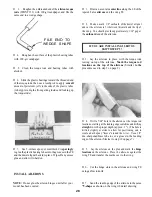
FINISHING
BALANCE THE AIRPLANE LATERALLY
SPECIAL NOTE: Do not confuse this procedure with
"checking the C.G." or "balancing the airplane fore
and aft". That very important step will be covered
later in the manual.
D 1. Now that you have the basic airframe nearly
completed, this is a good time to balance the airplane
laterally (side-to-side). Here is how to do it:
D 2. Temporarily attach the wing and engine (with
muffler) to the fuselage.
D 3. With the wing level, lift the model by the engine
propeller shaft and the bottom of the rudder (this may
require two people). Do this several limes.
D 4. If one wing always drops when you lift, it means
that side is heavy. Balance me airplane by gluing weight
to the other wing tip. NOTE: An airplane that has been
laterally balanced will track better in loops and other
maneuvers.
FINAL SANDING
ing 1/2" wide strips of covering in the corners between the
fin and slab, and (on the bottom of the stab) between the
slab and the fuse sides. Next, cover the stab and fin with
pre-cut pieces that have a straight edge to overlap (1/8"+
overlap) the strips you previously applied. DO NOT,
under any circumstances, attempt to cut the covering
material after it has been applied to the fin and stab,
except around the leading and trailing edges and the
tip. Modelers who do this often cut through the covering
and part-way into the balsa stab. This can weaken the stab
to the point where it may fail in flight!
Recommended Covering Sequence:
1. 1/2" Strips as described in above note
2. Rudder left side
3. Rudder right side
4. Bottom of elevators
5. Top of elevators
6. Stab bottom
7. Stab top
8. Fuse bottom
9. Fuse sides
10. Turtle deck
11. Hatch
12. Fin left side
13. Fin right side
14. Bottom of ailerons
15. Top of ailerons
16. Bottom of left wing panel
17. Bottom of right wing panel
18. Top of left wing panel (overlap covering
1/4" at wing LE)
19. Top of right wing panel (overlap covering 1/2"
at the center and 1/4" at the LE)
20. Wing tips (both sides)
D 1. Nearly every imperfection in your wood structure
will show through the covering material; therefore, before
covering, you should make a final check of the entire
structure. Fix any "dings," then sand the entire structure
smooth using progressively finer grades of sandpaper.
COVERING
D 1. Because it is assumed that you have had some
previous model building experience, we won't go into
detail in regard to the covering procedure. Follow the
instructions included with your covering material.
NOTE: When covering the fin and stab, begin by apply-
ATTACH THE WING TIPS
D 1. Hold the wing tips against the tip ribs. Make sure
they are lined up properly and use a felt tip marker to mark,
on the tip, around the airfoil. Cut the covering away from
34
Summary of Contents for FUN-ONE
Page 5: ...5...







































